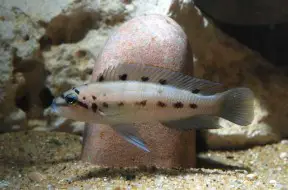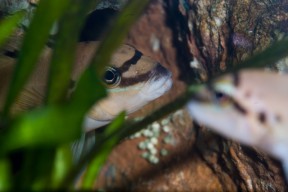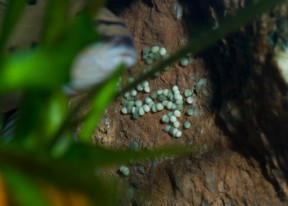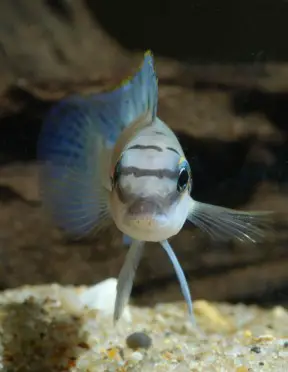Chalinochromis sp. 'ndobhoi'
Classification
Order: Perciformes Family: Cichlidae
Distribution
Thus far known only from a relatively limited portion of Lake Tanganyika’s eastern shore in Tanzania, between Bulu Point and Kasoje on the mainland and around Karilani Island just offshore.
Tanganyika is the most ancient of Africa’s Great Rift Lakes and contains around 250 described species of endemic cichlid which exhibit great diversity in terms of morphology, behaviour, and ecology. This variability has evolved through a process of explosive speciation and is often referred to as a model example of adaptive radiation i.e. the rapid differentiation of a single ancestor into an array of species possessing different traits in order to exploit particular niches in environments and resources.
Habitat
Members of this genus occupy a similar ecological niche to Julidochromis spp. within Lake Tanganyika whereby they’re adapted to occupy the spaces between and beneath rocky structures carpeted with biofilm, most often along rugged shorelines, spending little time in open water.
Maximum Standard Length
Males to 100 – 120 mm; females 80 – 90 mm.
Aquarium SizeTop ↑
Minimum base dimensions of 120 ∗ 45 cm are recommended even for a single pair since when not spawning males and females tend to occupy separate territories which can prove problematic in small aquaria.
Maintenance
A sandy substrate with some complex structures of piled rocks arranged to fill much of the available space represents the ideal environment. Place the latter directly on the base of the tank before adding the substrate in order to prevent them being toppled by the digging activity of the fish. Water quality must be of the highest order meaning weekly water changes of up to 50% should be considered mandatory.
If keeping multiple males of Chalinochromis together or within a community containing other rock-dwelling species it generally proves beneficial to arrange the décor in order that two or more distinct territories are formed. The most commonly-employed method is simply to place rocks in piles and separate them via short stretches of open substrate.
Water Conditions
Temperature: 24 – 28 °C
pH: 8.0 – 9.0
Hardness: 125 – 447 ppm
Diet
Possesses specialised mouthparts, characterised by its fleshy, thickened lips, allowing it to prey on invertebrates sharing its habitat with freshwater sponges a particular preference. Captive specimens will normally accept dried foods (use a quality product with added vegetable content) but should also be offered live and frozen chironomid (bloodworm) and mosquito larvae, Daphnia, Artemia, Mysis and similar.
Behaviour and CompatibilityTop ↑
Can be kept in a community provided tankmates are chosen with care since males become highly territorial once they begin to mature. Other rockdwellers such as Julidochromis spp. are best avoided in all but the largest displays and it should not be mixed with other Chalinochromis spp. under any circumstances as they will undoubtedly hybridise.
Should a group be purchased they will form a dominance hierarchy within which there will always be occasional skirmishes, but should a pair form the others will no longer be tolerated in their territory in most cases.
Sexual Dimorphism
Not pronounced though in mature male specimens the genital papilla is clearly visible as a small projection which is absent in females.
Reproduction
Biparental substrate spawner, and easy to breed in aquaria. According to reports it will remain monogamous if offered only a single partner but revert to the, presumably natural, state of changing partners between reproductive episodes should the option be available.
The eggs are deposited in a cave or otherwise sheltered area and attached to a solid surface where they remain for several days post-hatching as the yolk sacs are absorbed. The female is reponsible for direct tending of the brood while the male defends a small territory surrounding the site with parental care continuing for 6-8 weeks once the fry are free-swimming.
Once the adults lose interest in the fry they often spawn again immediately with older fry then not permitted to enter the territory until the new brood reach the free-swimming stage. Provided sufficient space is available several generations may coexist in this way. When such a colony is maintained young individuals have been observed to pick at the body of adults and it’s thought they’re feeding on body mucus or small parasites lodged in the skin.
NotesTop ↑
This undescribed species is also traded as C. sp. ‘ndoboi’ or ‘ndobnoi’, and despite its lack of official recognition it’s the most commonly-encountered member of the genus in the aquarium trade at time of writing. It can be easily-distinguished from the congeners C. brichardi and C. popelini by its adult body patterning which comprises two or three series of irregular, dark, laterally-orientated blotches, the upper of which is often contained entirely within the dorsal fin. In comparison these markings are fused together as solid stripes in C. popelini and absent altogether in C. brichardi.
Chalinochromis currently consists of two described plus at least two undescribed species and is often grouped within the putative subfamily Lamprologini, most members of which are endemic to Tanganyika though a few have penetrated fluvial habitats in the Congo River system (connected to the lake via the outflowing Lukuga River). There are currently eight genera included, namely Altolamprologus Poll, 1986, Chalinochromis Poll, 1974, Julidochromis Boulenger, 1898, Lamprologus Schilthuis, 1891, Lepidiolamprologus Pellegrin, 1904, Neolamprologus Colombe and Allgayer, 1985, Telmatochromis Boulenger, 1898, and Variabilichromis Colombe and Allgayer, 1985.
Chalinochromis spp. have long been thought allied to the genus Julidochromis and in their phylogenetic analyses Day et al. (2007) and Sturmbauer et al. (2010) found that the latter can be split into two distinct groupings. One contains J. transcriptus, J. ornatus, and J. dickfeldi and forms a clade alongside Chalinochromis, while J. marlieri and J. regani were only distantly-related and closely affiliated to various Neolamprologus and Telmatochromis species rather than other Julidochromis.
The most convincing explanation for this is that it represents a case of convergent evolution meaning there exist clear taxonomic implications. Day et al. concluded that Chalinochromis should be placed in synonymy of Julidochromis although this suggestion did not achieve general acceptance, presumably because the reassignment of Chalinochromis would not resolve the issue of a polyphyletic Julidochromis. Sturmbauer et al. alternatively proposed that J. marlieri and J. regani could be retained in Julidochromis with the other three species being moved to Chalinochromis but this recommendation disregards ICZN rules since J. ornatus is the type species of Julidochromis and therefore must retain the name in the event of any taxonomic reordering.
References
- Day, J. J., S. Santini, and J. Garcia-Moreno, 2007 - Molecular Phylogenetics and Evolution 45(2): 629–642
Phylogenetic relationships of the Lake Tanganyika cichlid tribe Lamprologini: the story from mitochondrial DNA - Sturmbauer, C., W.Salzburger, N. Duftner, R. Schelly and S. Koblmüller, 2010 - Molecular Phylogenetics and Evolution 57(1): 266–284
Evolutionary history of the Lake Tanganyika cichlid tribe Lamprologini (Teleostei: Perciformes) derived from mitochondrial and nuclear DNA data. - Takahashi, T., 2003 - Ichthyological Research 50(4): 367–382
Systematics of Tanganyikan cichlid fishes (Teleostei: Perciformes).







